Volcano Live
volcanolive.com
Gaua Volcano | John Seach

Gaua Island, Torba Province, Vanuatu
14.27 S, 167.50 E,
summit elevation 979 m
Shield Volcano
Gaua is a large shield volcano with gentle outer slopes, a large caldera lake (Lake Letas), and summit cinder cone (Mt Garet). The caldera is 8 x 6 km in diameter. Lake Letas occupies half the caldera with an area of 19.7 sq km. It is about 100 m deep and flat bottomed. There is warm, sulphur stained water near Mt Garet cone.
Gaua Island lies just north of the Santa Maria Fracture Zone, which runs perpendicular to the north New Hebrides Trench. In December 2011 Gaua volcano was changed from dormant to permanently active.
Gaua volcano photos by John Seach
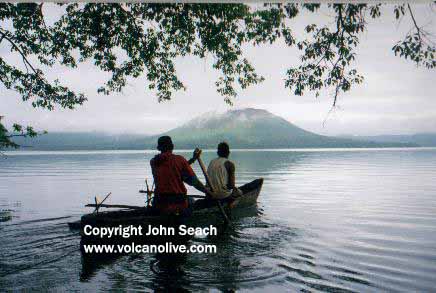
Mt Garet and Lake Letas, 1999 - John Seach

Crossing lake Letas to Mt Garet volcano on Gaua Island.
This freshwater volcanic lake is at 500 m elevation and the
water rises and falls with the tides!!
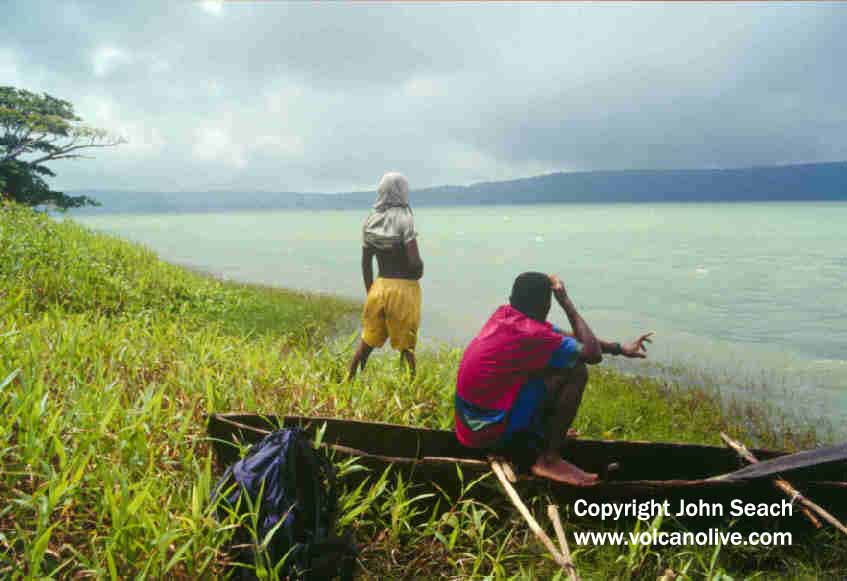
Eastern flank of Mt Garet cone in 1999, John Seach
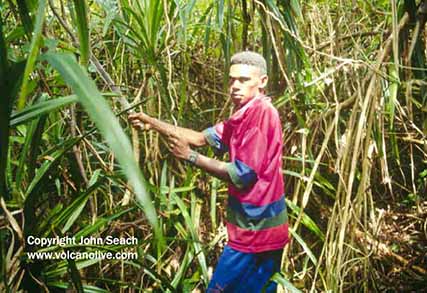
Cutting a new path through the jungle on Gaua was difficult. Moving 50 m took
one hour of hard work. This was the first ever ascent of Gaua volcano from SE.
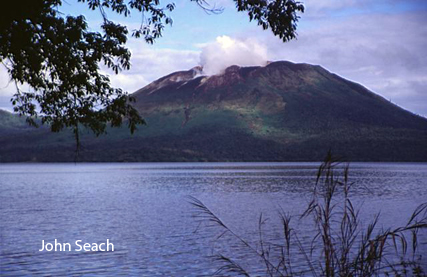
Gaua volcano 1999
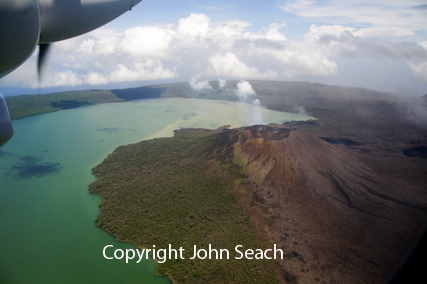
Gaua volcano
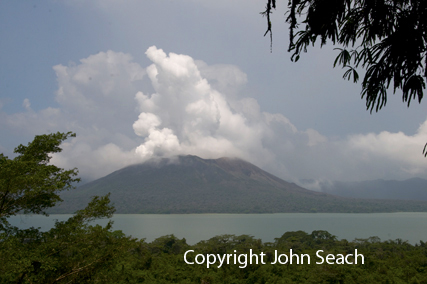
Gaua Volcano
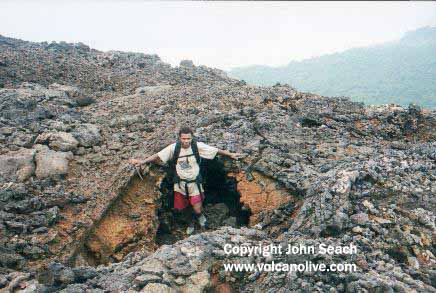
Lava tube on summit of Mt Garet, Gaua Island
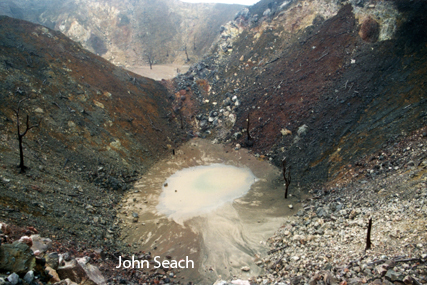
Gaua volcano crater 1999
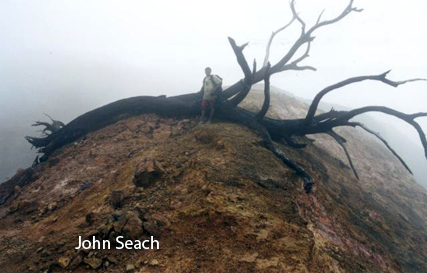
Fallen devastated tree. Crater rim of Gaua volcano, Vanuatu
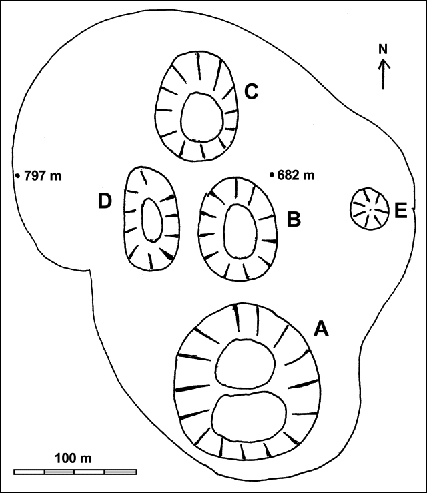
Sketch map showing the positions of the five summit craters (A-E) on Mt. Garat within the Gaua caldera (larger solid line), 6-10 September 1999. Map by John Seach
2022 Eruption
A small ash eruption occurred at Gaua volcano on 3 May 2022.
2013 Eruption
A short-lived eruption was reported at Gaua volcano on 30th April 2013. Ash emissions reached 10,000 ft altitude.
2009-10 Eruption
February 2010
Eruptions have increased at Gaua volcano, Vanuatu during January. Ash emissions have increased significantly since 16th January. Ash emissions reached a height 3000 m. Strombolian eruptions occurred on 24th January. Explosions were seen and heard from villages on the east coast of Gaua on 29th January. Water level in Lake Letas has risen up to 30 cm since 22nd January. People are advised to avoid the volcano until further notice.
Report from 1st October 2009. Gaua volcano in Vanuatu is showing signs of unrest. During the past few days the volcano has emitted large quantity of "smoke". People on the island have noticed a strong sulphur smell. Residents have been advised to stay away from Mt Garet cone. During the first week of October 2009 observers at Gaua volcano caldera reported an eruption accompanied by earthquakes, black smoke and ash emission.
An assessment of Gaua volcano was made by staff from Vanuatu Geohazards Observatory from 3-7 October 2009. The survey confirmed an eruptive phase began at Gaua from the 27th of September 2009. Volcanic gas measurements on 3rd October show that 3000 tons of sulphur dioxide was released from Gaua volcano daily. The alert level has been raised to 2 (on a scale of 0-4). People are advised to stay away from the summit area.
An increase in activity at Gaua volcano, Vanuatu has forced the evacuation of over 300 people from three villages on the west coast of Gaua Island on 26th November 2009. People have been suffering from respiratory problems in the last few days as a strong wind has carried the gas and ash over villages. Two boats from the police and health department in Torba are starting to evacuate people this morning. Negotiations are taking place with ships owners to help with the evacuation because the two motor boats cannot carry enough people. Chiefs from two villages, Namasari and Lembot, from the east of Gaua met yesterday about housing the relocated people. The National Disaster Management Office has maintained the level of alert on 2 (out of a maximum 4) but during the past days, a fall and gas emission has increased.
Renewed eruptive activity occurred at Gaua volcano, Vanuatu on 14th December. Ash emissions were darker than before, and fall in the western side of the island. On 17th December 3000 tonnes of sulphur dioxide were emitted.
1999 Expedition by John Seach
During a 6-10 September visit by John Seach to the Gaua caldera and the cone of Mt. Garat, of the five craters only Crater A was solfatarically active. The W side of the caldera lake was stained yellow by sulfurous mud and emitted a strong SO2 smell. The water temperature was measured at 30.1°C while that of the lake shore mud was 35.1°C. The Mt. Garat cone was largely denuded of vegetation around the craters. Only on the NE side near Crater E was there any regrowth on top. Moss and grasses had regrown on the flanks of the cone, to within 20 m of the E side of Crater E. Fallen trees were scattered around the rims of all five craters.
Hot, whistling ground with a temperature of 97.6°C was located 20 m S of the Mt. Garat summit, located along the W summit crater rim. Fumarole fields were found both inside and outside of the summit crater rim. Another fumarole field with a temperature of 45.3°C was located ~25 m SW of Crater B. Steam was observed venting ~2 km SW of Crater E but was not approached due to its remote location.
The active Crater A is located on the SE side of the Mt. Garat cone. The E crater wall contained solfataras emitting white vapor with a strong SO2 smell and a temperature of 95.0°C. The solfataras were surrounded by bright yellow deposits, and were active up to the rim of the crater. Solfatara plumes were easily visible from a distance of 5 km on the E shore of the lake. On the SE crater floor, a solfatara constantly vented 102.7°C vapor. Continuous loud high-pressure venting noises originated from along the N and W walls and the W floor of the crater. A pile of blocks coated in yellow deposits rested on the SW floor; mild degassing with a temperature of 99.7°C occurred here. Large blocks 1-2 m in diameter littered the SW wall and floor of the crater. The floor of the crater was split into two levels with the N level being ~5 m below the S level. Large cracks ~3 m deep were present on the S floor. Two 3-m-diameter blocks sat near a brown pond on the low, N-level floor. Rockfalls were heard coming from the E wall. Mild acid rain fell inside the crater, which was mostly filled with white vapor. At times, twin plumes emitting from the crater were visible, rising to a height of 100 m.
Craters B and C are similar in size and depth (figure 2), are denuded of vegetation, contain standing, devastated trees (figure 3), have and flat silty floors with brown ponds. The crater walls contain tuffs, cinders, and scattered blocks. Crater D is the shallowest of the five and has a flat and silty floor containing a shallow brown pond and standing, devastated trees. A 3 m-diameter block was observed on the E wall. Crater E is the smallest crater, ~20 m wide and 20 m deep. It is cone-shaped with blocks and a full cover of vegetation inside.
1973 Eruptions
In 1973 eruptions caused the evacuation of residents.
1971 Eruption
Minor ash emissions occurred on 12-13 May 1971.
1969 Eruptions
A small ash emission occurred at Gaua volcano on 22nd September 1969.
1968 Eruptions
Small emissions of ash and steam occurred in late 1968.
1967 Eruption
A small ash emission occurred at Gaua volcano in July 1967.
1966 Eruptions
Periodic small ash emissions occurred in 1966.
1965 Eruption
A 3-day eruption occurred at Gaua volcano on 27th September 1965. Ash was emitted to a height of 6000 m.
1963 Eruptions
A new vent opened on the SE side of Mt Garet in September 1963. Dark grey ash was visible from Vanua Lava Island, 50 km away.
1962 Eruptions
No eruptions were recorded at Gaua volcano until 1962. In July 1962 vegetation was damaged on the western slope of Mt Garet.
Further reading
Robin, C., Eissen, J.P. and Monzier, M., 1995. Mafic pyroclastic flows at Santa Maria (Gaua) volcano, Vanuatu: the caldera formation problem in mainly mafic island arc volcanoes. Terra Nova, 7(4), pp.436-443.
Bani, P., Boudon, G., Balcone-Boissard, H., Delmelle, P., Quiniou, T., Lefèvre, J., Bule, E.G., Hiroshi, S. and Lardy, M., 2016. The 2009–2010 eruption of Gaua volcano (Vanuatu archipelago): Eruptive dynamics and unsuspected strong halogens source. Journal of Volcanology and Geothermal Research, 322, pp.63-75.
Gaua Volcano Eruptions
2022, 2013, 2009-10, 1982, 1981, 1980, 1977, 1976, 1973-74, 1971, 1969, 1968, 1967, 1966, 1965, 1963, 1962